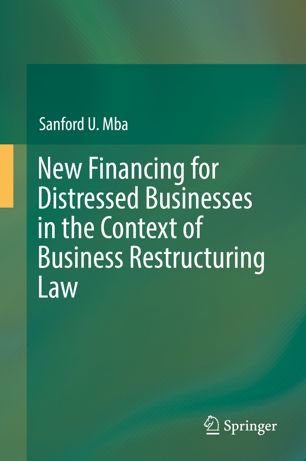

Most ebook files are in PDF format, so you can easily read them using various software such as Foxit Reader or directly on the Google Chrome browser.
Some ebook files are released by publishers in other formats such as .awz, .mobi, .epub, .fb2, etc. You may need to install specific software to read these formats on mobile/PC, such as Calibre.
Please read the tutorial at this link. https://ebooknice.com/page/post?id=faq
We offer FREE conversion to the popular formats you request; however, this may take some time. Therefore, right after payment, please email us, and we will try to provide the service as quickly as possible.
For some exceptional file formats or broken links (if any), please refrain from opening any disputes. Instead, email us first, and we will try to assist within a maximum of 6 hours.
EbookNice Team

Status:
Available4.4
8 reviewsThis book focuses on the restructuring of distressed businesses, emphasizing the need for new financing during the restructuring process as well as during relaunch, and examines the role of law in encouraging creditor confidence and incentivizing lending. It describes two broad approaches to encouraging new finance during restructuring: a prescriptive one that seeks to attract credit using expressly defined statutory incentives, and a market-based one that relies on the business judgment of lenders against the backdrop of transaction avoidance rules.
Securing new financing for a distressed business is a critical part of successful restructuring. Without such financing, the business may be unable to meet interim liquidity constraints, or to implement its restructuring plans. This book addresses related questions concerning the place of new financing as an essential component of restructuring.In general terms, the book explores how statutory interventions and the courts can provide support with contentious issues that arise from the provision of new financing, whether through new financing agreements or through distressed debt investors, who are increasingly gaining prominence as sources of new financing for distressed businesses. It argues that courts play a key part in preventing or correcting the imbalances that can arise from the participation of distressed debt investors. In this context, it critically examines the distressed debt market in emerging markets like Nigeria and the opportunity presented by non-performing loans, arguing that the regulatory pattern of market entry may dis-incentivize distress debt investing in a market that is in dire need of financing.The book offers a fresh and comparative perspective on restructuring new financing for distressed businesses by comparing various approaches (primarily from the US, UK and Germany) and drawing lessons for frontier markets, with particular reference to Nigeria. It fills an important gap in international comparative scholarship and discusses a living problem with both empirical and policy aspects.